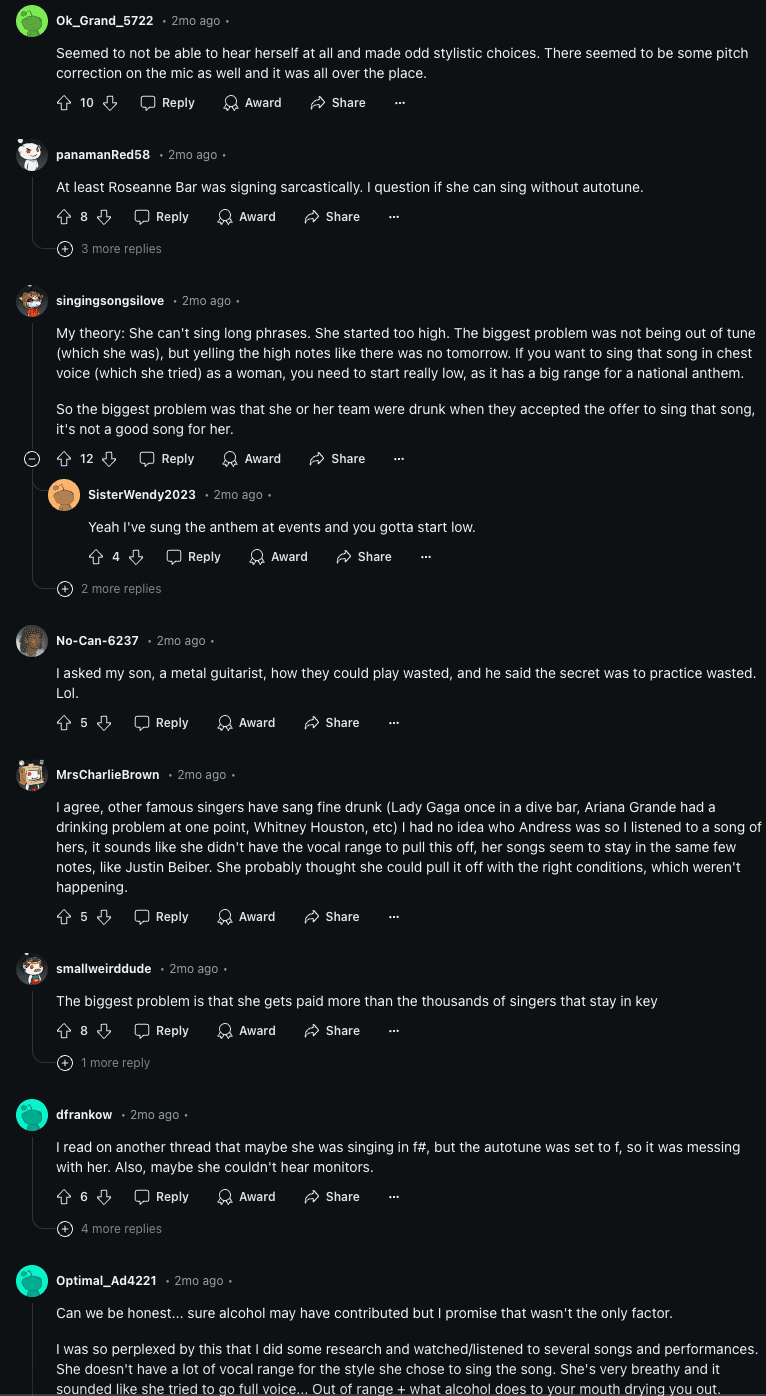The performance of the United States National Anthem is a significant moment at any event, often setting the tone for what follows. Recently, country music artist Ingrid Andress found herself at the center of controversy following her rendition of “The Star-Spangled Banner.” This article provides a comprehensive analysis of the incident, including the performance itself, public reactions, Andress’s response, and the broader implications of the event.
The Setting and Occasion
Ingrid Andress was invited to perform the national anthem at a major sporting event. The occasion was a highly anticipated game, with thousands in attendance and millions more watching from home. As is customary, Andress took center stage before the start of the game, with all eyes and cameras focused on her.
Analysis of the Performance Video
Video footage of Andress’s performance quickly circulated online. The recording shows Andress beginning confidently, her voice clear and strong. However, as she progressed through the anthem, several notable moments caught viewers’ attention:
- At the line “O’er the ramparts we watched,” Andress appeared to hesitate briefly, seemingly unsure of the lyrics.
- During the phrase “rocket’s red glare,” her voice wavered slightly, possibly due to nerves or difficulty with the high notes.
- Most significantly, Andress stumbled over the words “land of the free,” momentarily losing her place in the song.
Despite these challenges, Andress managed to complete the performance, receiving polite applause from the audience.
Initial Public and Media Reactions
The reaction to the performance was immediate and mixed. Social media immediately was flooded with comments and reactions like:

- Many viewers expressed disappointment, feeling that the performance did not meet the standards expected for such an important song.
- Some criticized Andress for not being adequately prepared, suggesting that she should have practiced more thoroughly.
- Others defended Andress, pointing out the pressure of performing live and the difficulty of the anthem itself.
- A few commentators used the incident to spark discussions about the challenges of performing the national anthem and whether alternatives should be considered.
Media outlets quickly picked up the story, with entertainment news programs and websites featuring clips of the performance and analyzing Andress’s missteps. Music critics weighed in, offering their professional opinions on the technical aspects of the rendition.
Ingrid Andress’s Response and Apology
In the face of mounting criticism, Ingrid Andress chose to address the situation directly. She released a statement on her social media accounts and through her publicist:
“I want to sincerely apologize for my performance of the national anthem. I understand the importance of this song to our nation and its people. Nerves got the better of me, and I fell short of the standard I set for myself and that the anthem deserves. I take full responsibility for my mistakes and am committed to learning from this experience.”
Andress went on to explain that she had indeed prepared extensively for the performance but that the pressure of the moment affected her more than she had anticipated. She expressed her deep respect for the anthem and for those who have served the country.
Wider Implications and Discussions
The incident sparked broader conversations about national anthem performances:
- Some questioned whether live performances of the anthem should be replaced with recorded versions to avoid such mishaps.
- Others debated the pressure placed on performers and whether the difficulty of the song itself contributes to these incidents.
- The role of social media in amplifying such moments and its impact on performers’ mental health was also discussed.
- Some commentators used the opportunity to revisit discussions about patriotism and the significance of the national anthem in modern society.
Comparisons to Similar Controversies
Andress’s performance is not the first to generate controversy. Other notable incidents include:
- Christina Aguilera’s 2011 Super Bowl performance, where she mixed up the lyrics.
- Fergie’s jazz-inspired rendition at the 2018 NBA All-Star Game, which was widely criticized for its unusual style.
- Roseanne Barr’s intentionally comedic and off-key performance at a 1990 baseball game, which drew significant backlash.
These comparisons highlight that while Andress’s situation is not unique, each incident is judged within its own context and time.
Impact on Ingrid Andress’s Career
The long-term effects of this incident on Andress’s career remain to be seen. However, some immediate impacts were observed:
- A temporary increase in media attention, both positive and negative.
- Increased scrutiny of her upcoming performances and releases.
- Potential hesitation from event organizers to book her for high-profile live performances in the near future.
Despite these challenges, many in the music industry have expressed support for Andress, recognizing her talent and previous accomplishments. Her response to the situation, including her apology, has been generally well-received, which may help mitigate long-term damage to her public image.
Lessons Learned and Changes Implemented
In the wake of this incident, several lessons and potential changes have been discussed:
- Increased emphasis on thorough preparation for national anthem performances, including multiple rehearsals under simulated pressure.
- Consideration of providing performers with in-ear monitors or teleprompters to assist with lyrics and timing.
- Discussions about potentially simplifying the anthem or choosing alternative patriotic songs for some events.
- Greater awareness of the mental health support needed for performers facing high-pressure situations.
Some event organizers have already implemented changes, such as more rigorous audition processes for anthem singers and additional support systems for performers.
Conclusion
Ingrid Andress’s national anthem performance is a reminder of the challenges faced by the artists in the high-pressure situations. While her stumbles during the anthem led to significant criticism, her response and apology demonstrated professionalism and humility. The incident has sparked important discussions about the nature of live performances, the pressure placed on artists, and the role of patriotic symbols in modern society.
After the hubbub has subsided, the episode will most likely be a clinical teaching for not only Andress but the entire entertainment industry. Thorough discussions on the best approaches to the national anthem performances may give room to development, so that it can cater best to both the performers and the audience.
Indeed, music has the power to move people and that is the reason why the ones, who are engaged in representing culture, should always carry forward this responsibility. In the process, it is equally important to keep tradition in harmony with the understanding and support for the artists who advance these major cultural implications.



 Bitcoin
Bitcoin  Ethereum
Ethereum  Tether
Tether  XRP
XRP  Solana
Solana  USDC
USDC  Cardano
Cardano  TRON
TRON  Lido Staked Ether
Lido Staked Ether  Avalanche
Avalanche  Toncoin
Toncoin